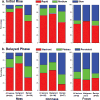The diverse pathology and kinetics of mass, nonmass, and focus enhancement on MR imaging of the breast
- PMID: 21591007
- PMCID: PMC3098464
- DOI: 10.1002/jmri.22567
The diverse pathology and kinetics of mass, nonmass, and focus enhancement on MR imaging of the breast
Abstract
Purpose: To compare the pathology and kinetic characteristics of breast lesions with focus-, mass-, and nonmass-like enhancement.
Materials and methods: A total of 852 MRI detected breast lesions in 697 patients were selected for an IRB approved review. Patients underwent dynamic contrast enhanced MRI using one pre- and three to six postcontrast T(1)-weighted images. The "type" of enhancement was classified as mass, nonmass, or focus, and kinetic curves quantified by the initial enhancement percentage (E(1)), time to peak enhancement (T(peak)), and signal enhancement ratio (SER). These kinetic parameters were compared between malignant and benign lesions within each morphologic type.
Results: A total of 552 lesions were classified as mass (396 malignant, 156 benign), 261 as nonmass (212 malignant, 49 benign), and 39 as focus (9 malignant, 30 benign). The most common pathology of malignant/benign lesions by morphology: for mass, invasive ductal carcinoma/fibroadenoma; for nonmass, ductal carcinoma in situ (DCIS)/fibrocystic change(FCC); for focus, DCIS/FCC. Benign mass lesions exhibited significantly lower E(1), longer T(peak), and lower SER compared with malignant mass lesions (P < 0.0001). Benign nonmass lesions exhibited only a lower SER compared with malignant nonmass lesions (P < 0.01).
Conclusion: By considering the diverse pathology and kinetic characteristics of different lesion morphologies, diagnostic accuracy may be improved.
Copyright © 2011 Wiley-Liss, Inc.
Figures




References
-
- Newstead GM. MR imaging in the management of patients with breast cancer. Semin Ultrasound CT MR. 2006;27:320–332. - PubMed
-
- Saslow D, Boetes C, Burke W, et al. American Cancer Society guidelines for breast screening with MRI as an adjunct to mammography. CA Cancer J Clin. 2007;57:75–89. - PubMed
-
- Beatty JD, Porter BA. Contrast-enhanced breast magnetic resonance imaging: the surgical perspective. Am J Surg. 2007;193:600–605. discussion 605. - PubMed
-
- Kuhl C, Kuhn W, Braun M, Schild H. Pre-operative staging of breast cancer with breast MRI: one step forward, two steps back? Breast. 2007;16 (Suppl 2):S34–44. - PubMed
Publication types
MeSH terms
Substances
Grants and funding
LinkOut - more resources
Full Text Sources
Medical

